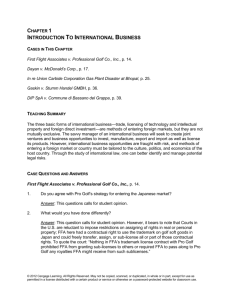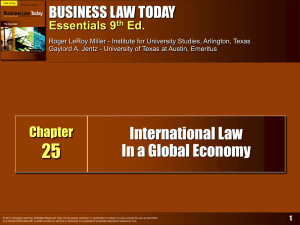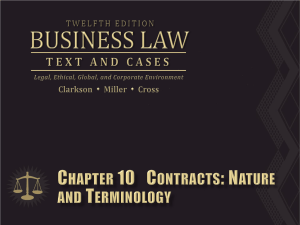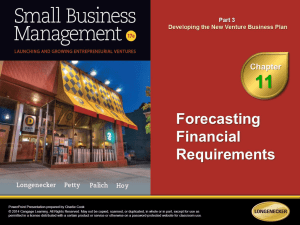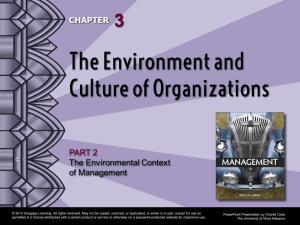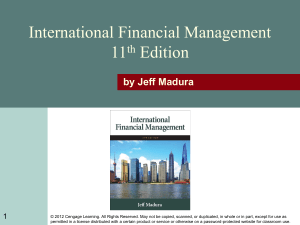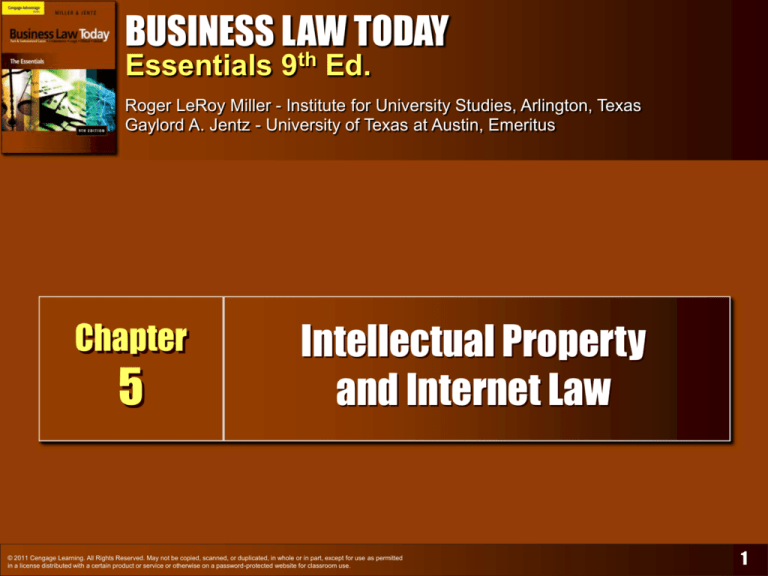
BUSINESS LAW TODAY
Essentials 9th Ed.
Roger LeRoy Miller - Institute for University Studies, Arlington, Texas
Gaylord A. Jentz - University of Texas at Austin, Emeritus
Chapter
5
Intellectual Property
and Internet Law
© 2011 Cengage Learning. All Rights Reserved. May not be copied, scanned, or duplicated, in whole or in part, except for use as permitted
in a license distributed with a certain product or service or otherwise on a password-protected website for classroom use.
1
Learning Objectives
What is intellectual property?
Why does the law protect trademarks and
patents?
What laws protects authors’ rights in
works they produce?
What are trade secrets, and what laws
offer protection for this form of intellectual
property?
What steps have been taken to protect
intellectual property rights in the digital
age?
© 2011 Cengage Learning. All Rights Reserved. May not be copied, scanned, or duplicated, in whole or in part, except for use as permitted
in a license distributed with a certain product or service or otherwise on a password-protected website for classroom use.
2
Introduction
Intellectual Property (I.P.) is any property that
is the product of an individual’s mind, e.g,
books, software, movies, music.
U.S. Constitution protects I.P. in Article I
Section 8. Congress shall:
“promote the Progress of Science and useful
Arts, by securing for limited times to Authors
and Inventors the exclusive right to their
respective Writings and Discoveries.”
Ownership of I.P. is strategically important in
the global economy.
© 2011 Cengage Learning. All Rights Reserved. May not be copied, scanned, or duplicated, in whole or in part, except for use as permitted
in a license distributed with a certain product or service or otherwise on a password-protected website for classroom use.
3
Trademarks & Related Property
Trademark.
Distinctive motto, mark or emblem.
Stamped or affixed to a product.
So that it can be identified in the market.
CASE 5.1 The Coca-Cola Co. v. Koke Co.
of America.
Name “Coke” was so common that use of
“Koke” by competing company was a trademark
infringement.
© 2011 Cengage Learning. All Rights Reserved. May not be copied, scanned, or duplicated, in whole or in part, except for use as permitted
in a license distributed with a certain product or service or otherwise on a password-protected website for classroom use.
4
Trademarks & Related Property
Statutory Protection for
Trademarks.
Lanham Act of 1946 provides federal
protection of manufacturers from loosing
business to rivals that used confusingly
similar brands and products.
© 2011 Cengage Learning. All Rights Reserved. May not be copied, scanned, or duplicated, in whole or in part, except for use as permitted
in a license distributed with a certain product or service or otherwise on a password-protected website for classroom use.
5
Trademarks & Related Property
Trademark Dilution Act of 1995.
Amended Lanham Act to bring federal
cause of action in federal court for
trademark dilution –even when mark is
unlikely to confuse. “Similar” marks may
give rise to dilution suit.
© 2011 Cengage Learning. All Rights Reserved. May not be copied, scanned, or duplicated, in whole or in part, except for use as permitted
in a license distributed with a certain product or service or otherwise on a password-protected website for classroom use.
6
Trademarks & Related Property
Trademark Registration.
U.S. Patent and Trademark Office
www.uspto.gov gives notice to 3rd
parties.
A mark can be registered if in use or
mark will be used within 6 months.
Trademark Infringement.
Unintentional or intentional substantial
copying of mark.
© 2011 Cengage Learning. All Rights Reserved. May not be copied, scanned, or duplicated, in whole or in part, except for use as permitted
in a license distributed with a certain product or service or otherwise on a password-protected website for classroom use.
7
Distinctiveness of the Mark
Strong Marks: fanciful, arbitrary, or
suggestive trademarks are most distinctive
marks, normally not related to product
(Apple, Xerox, Starbucks).
Secondary Meaning: descriptive,
geographical, or personal names do not
acquire protection until consumers
associate term with product (London Fog).
Generic Terms: no protection (bicycle,
computer).
© 2011 Cengage Learning. All Rights Reserved. May not be copied, scanned, or duplicated, in whole or in part, except for use as permitted
in a license distributed with a certain product or service or otherwise on a password-protected website for classroom use.
8
Service, Certification, and Collective Marks
Service Mark: similar to trademark but
used for services (includes TV and
radio).
Certification Mark: quality of goods
(UL tested, Good Housekeeping).
Collective Mark: used by members of
a cooperative, association, union.
© 2011 Cengage Learning. All Rights Reserved. May not be copied, scanned, or duplicated, in whole or in part, except for use as permitted
in a license distributed with a certain product or service or otherwise on a password-protected website for classroom use.
9
Trade Dress
Trade Dress.
Protects image and appearance of a product
or store (Example: fish shape of cracker,
Starbucks stores).
Counterfeit Goods.
Stop Counterfeiting in Manufactured Goods
Act criminalizes intentional trafficking in
counterfeit goods.
Trade Names.
Indicates all or part of a business name that is
protected (Example: Safeway).
© 2011 Cengage Learning. All Rights Reserved. May not be copied, scanned, or duplicated, in whole or in part, except for use as permitted
in a license distributed with a certain product or service or otherwise on a password-protected website for classroom use.
10
Cyber Marks
Domain Names.
Trademarks in Cyberspace (example:
Nike.com).
Conflicts—ICANN.
Anticybersquatting Legislation.
Occurs when 3d party registers a domain
name that is the same or similar to another
company’s own trade name.
1999 Anticybersquatting Consumer
Protection Act.
© 2011 Cengage Learning. All Rights Reserved. May not be copied, scanned, or duplicated, in whole or in part, except for use as permitted
in a license distributed with a certain product or service or otherwise on a password-protected website for classroom use.
11
Cyber Marks
Meta Tags
Keywords in web pages used by internet
search engines.
Playboy Enterprises, Inc. v. Welles
(2002).
Dilution in the Online World.
Trademarks can be diluted on the web.
Hasbro v. IEG (over candyland.com).
© 2011 Cengage Learning. All Rights Reserved. May not be copied, scanned, or duplicated, in whole or in part, except for use as permitted
in a license distributed with a certain product or service or otherwise on a password-protected website for classroom use.
12
Cyber Marks
Licensing.
Agreement that permits use of trademark,
copyright, or patent in cyber space.
Owner is licensor, user is licensee.
Terms of the use are delineated in the license
agreement.
CASE 5.2
George V Restauration S.A. v.
Little Rest Twelve, Inc. (2009).
Owners of mark would suffer ‘irreparable harm’
and consumer confusion if use of mark continued
by licensee.
© 2011 Cengage Learning. All Rights Reserved. May not be copied, scanned, or duplicated, in whole or in part, except for use as permitted
in a license distributed with a certain product or service or otherwise on a password-protected website for classroom use.
13
Patents
Patent: government monopoly that gives
inventor the exclusive right to make, use or sell
and invention for 20 years.
What is Patentable?
Item must be novel and not “obvious”. Almost
anything is patentable (excluding laws of
nature, natural phenomena, abstract ideas).
CASE 5.3 KSR International Co. v. Teleflex,
Inc. (2007).
Patent for automobile pedal sensor was invalid
because it was obvious and combined pre-existing
inventions.
© 2011 Cengage Learning. All Rights Reserved. May not be copied, scanned, or duplicated, in whole or in part, except for use as permitted
in a license distributed with a certain product or service or otherwise on a password-protected website for classroom use.
14
Patents
Patent Infringement.
Manufacture, use or sale of another’s
product or design without permission
(license).
Remedies for Patent Infringement.
Injunction.
Damages for royalties.
Reimbursement for attorney’s fees and
costs.
© 2011 Cengage Learning. All Rights Reserved. May not be copied, scanned, or duplicated, in whole or in part, except for use as permitted
in a license distributed with a certain product or service or otherwise on a password-protected website for classroom use.
15
Copyrights
Intangible property right automatically
granted by federal statute to the author
for life plus 70 years.
What is Protected Expression?
Work must be original and “fixed in a durable
medium.” Ideas are not protected, but the
expression of an idea is.
Section 102 Exclusions.
Compilation of facts is protected.
© 2011 Cengage Learning. All Rights Reserved. May not be copied, scanned, or duplicated, in whole or in part, except for use as permitted
in a license distributed with a certain product or service or otherwise on a password-protected website for classroom use.
16
Copyrights
Copyright Infringement.
Form or expression is copied (does not have to
be in its entirety).
Penalties, damages and criminal action are
possible.
The “Fair Use” Exception.
Certain persons or organization can copy
materials without penalty (e.g., education, news,
research).
Copyright Protection for Software.
© 2011 Cengage Learning. All Rights Reserved. May not be copied, scanned, or duplicated, in whole or in part, except for use as permitted
in a license distributed with a certain product or service or otherwise on a password-protected website for classroom use.
17
Copyrights in Digital Information
Digital media can easily be copied.
Anytime a copyright work is downloaded
and stored in RAM or hard drive without
permission, there is infringement.
Copyright Act of 1976:
Copy of a program into RAM is
infringement.
Revision or re-sale of freelance authors
works can be infringement.
© 2011 Cengage Learning. All Rights Reserved. May not be copied, scanned, or duplicated, in whole or in part, except for use as permitted
in a license distributed with a certain product or service or otherwise on a password-protected website for classroom use.
18
Copyrights: MP3 and File Sharing
Napster case.
P2P sharing, distributed network.
Metro-Goldwyn-Mayer Studios, Inc. v.
Grokster, Ltd., Supreme Court held that a
software company that distributes software
intending it to be used to violate copyright
laws can be vicariously liable for users
infringement.
What about the new “cloud network”?
© 2011 Cengage Learning. All Rights Reserved. May not be copied, scanned, or duplicated, in whole or in part, except for use as permitted
in a license distributed with a certain product or service or otherwise on a password-protected website for classroom use.
19
Trade Secrets
Trade secrets are confidential, not filed
with the government.
Can be customer lists, formulas, pricing,
etc.
Theft of trade secrets is now a federal
crime under the Economic Espionage
Act of 1996.
Cyberspace: employees can easily email
information to competitors.
© 2011 Cengage Learning. All Rights Reserved. May not be copied, scanned, or duplicated, in whole or in part, except for use as permitted
in a license distributed with a certain product or service or otherwise on a password-protected website for classroom use.
20
International Protection
Berne Convention (1886).
TRIPS Agreement (1994).
Each member must include domestic laws protecting
intellectual property of other nation-members.
World Intellectual Property Organization.
(WIPO) (1996).
Provides for Dispute resolution.
Madrid Protocol (2003).
U.S. company can
submit a single application to register its trademark
with all 73 member nations.
© 2011 Cengage Learning. All Rights Reserved. May not be copied, scanned, or duplicated, in whole or in part, except for use as permitted
in a license distributed with a certain product or service or otherwise on a password-protected website for classroom use.
21



